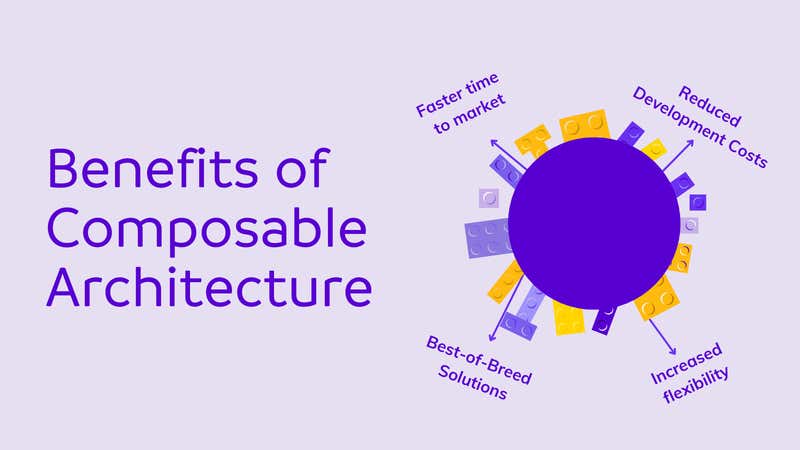What is Composable Architecture?


Composable architecture refers to an innovative approach in software development shaped by the need for flexibility, modularity, and adaptability in building digital solutions.
At its core, composability revolves around combining multiple specialized systems, with one of the key components typically being a headless Content Management System (CMS) handling the content.
The beauty of composable architecture lies in its modular nature, where each component is self-contained and stateless, enabling seamless integration and interaction between different systems through well-defined APIs.
The real power of composability comes to light when organizations can easily swap out and replace individual components without extensive coding efforts, akin to assembling Lego blocks. This capability allows businesses to tailor their solutions to specific user requirements, ensuring that each component serves a distinct purpose, avoiding the limitations of traditional monolithic platforms.
As the trend gains momentum, the future of composable architecture holds the promise of even more sophisticated connectors and frameworks, empowering businesses to choose the best-of-breed solutions and adapt to changing needs, ultimately shaping how software is developed and deployed in the evolving digital landscape.
What is the composable architecture trend?
The composable architecture trend has rapidly gained popularity as a revolutionary approach in software development. Its allure lies in the ability to create flexible and adaptive systems by assembling specialized components that can seamlessly communicate through APIs.
Unlike traditional monolithic platforms that offer limited customizability, composable architecture allows businesses to choose the best-fit solutions for their specific needs, fostering a "pick-and-choose" approach to building digital ecosystems.
This modularity empowers organizations to swiftly swap out or update individual components without extensive coding efforts, leading to faster innovation and agility. As businesses face ever-evolving technological landscapes and customer demands, the composable architecture trend provides a scalable and future-proof solution, enabling organizations to stay competitive and ahead of the curve in the dynamic world of technology.
Why is composable architecture becoming more popular and important?
In recent years, a transformative trend has taken the software development world by storm: Composable Architecture. This revolutionary approach to building systems is rooted in the evolution of platforms, specifically Content Management Systems (CMS), and originates in the concept of "composability."
Coined as a response to the limitations of monolithic systems, composability gained traction as organizations sought more flexibility, agility, and interoperability in their digital ecosystems. As a result, the composability trend has become increasingly popular, shaping how modern software is developed and empowering businesses to embrace a best-of-breed approach, leading to faster innovation and adaptability in a rapidly changing technological landscape.
Here’s why it’s sticking around:
- Flexibility and Agility: Composable architecture allows organizations to build their systems using multiple small, specialized components that can be easily interconnected. This approach offers flexibility, making swapping out or updating individual components easier without affecting the entire system. This flexibility enables faster rollouts and time-to-market, as changes can be made incrementally without extensive planning and reorganization.
- Headless CMS and Omni-channel Support: The rise of headless Content Management Systems (CMS) was driven by the need to support multi-channel publishing and customer interactions. Traditional monolithic systems were primarily focused on websites, but headless CMS opened up the possibility of using content across various channels and touchpoints. The composable architecture allows organizations to seamlessly integrate headless CMS and other systems, supporting various channels and devices.
- Interoperability and Integration: Composable systems enable smooth integration between various back-end systems. With APIs being a primary driver in headless CMS, different systems can communicate efficiently and share data. This interoperability makes combining best-of-breed solutions for specific problems, such as content management, search, commerce, personalization, and marketing automation, easier.
- JavaScript Front-end Technologies: The growth of JavaScript front-end frameworks and technologies has also contributed to the popularity of composable architecture. These technologies can be used across multiple devices and pull content from APIs and statically generated sources quickly and easily. This alignment of front-end and back-end technologies facilitates rapid development and adaptability.
- No-code and Low-code Models: Composable architecture moves away from the monolithic approach, which often requires heavy development efforts and deep knowledge of the entire system. Instead, it embraces no-code and low-code approaches, allowing teams to focus on building specific components without getting bogged down in complex code integrations.
Advantages of Composable Architecture: Unlocking the Power of Flexibility and Efficiency
In the ever-evolving software development landscape, businesses constantly seek innovative ways to improve their processes, accelerate time-to-market, and reduce costs. Composable architecture emerges as a promising solution that offers a myriad of advantages for organizations of all sizes. Let's delve deeper into these advantages and explore how composable architectures can transform how we build and deploy software solutions.

Increased Flexibility
Composable architecture introduces a modular design that enables businesses to swap out components seamlessly. This enhanced flexibility empowers development teams to focus on each module independently without disrupting other areas of the system. Unlike tightly-coupled monolithic solutions, where changes in one component may lead to cascading effects throughout the entire system, composable architectures allow for granular adjustments and optimizations.
By adopting a more modular approach, businesses can tailor their solutions to specific needs, accommodating diverse requirements across different functionalities. This adaptability allows for rapid updates and adjustments and encourages experimentation and continuous improvement.
Faster Time-to-Market
In the fast-paced digital world, time is of the essence. Composable architectures offer a significant advantage in reducing time-to-market for new products and features. Development teams can start working on individual components immediately without engaging in lengthy planning and preparation phases for the entire system.
This streamlined development process allows businesses to launch partial solutions quickly and gather valuable user feedback. The ability to release components iteratively and gather real-world data empowers organizations to make data-driven decisions, leading to more efficient and effective product enhancements.
Reduced Development Costs
Traditional monolithic systems often have substantial development costs, requiring specialized developers and extensive infrastructure. Composable architectures, on the other hand, reduce development costs by enabling more focused and specialized development efforts.
With composable systems, development teams can primarily focus on building the front end, as the modular components already represent the back-end functionalities. This approach allows for faster development cycles, as front-end work can be efficiently done using popular and widely adopted technologies like JavaScript.
Moreover, businesses can leverage the growing array of composable components and services. Instead of developing everything from scratch, organizations can assemble their solutions by selecting the best-of-breed components for their specific needs. This saves time and money and ensures that the resulting solution aligns perfectly with their requirements.
Best-of-Breed Solutions
Composable architecture allows businesses to cherry-pick the best-of-breed components. Instead of settling for a one-size-fits-all solution, organizations can tailor their technology stack to meet their unique demands.
This freedom of choice is a game-changer, as businesses can select components that excel in specific functionalities, performance, security, or any other criteria essential to their success. Consequently, composable architectures lead to higher-quality solutions that provide a competitive edge in the market.
Going Composable
Composable architecture emerges as a powerful and transformative approach to software development, offering advantages that empower businesses to thrive in the digital age. The increased flexibility, faster time-to-market, reduced development costs, and access to best-of-breed solutions pave the way for a more efficient, agile, and competitive software development process.
As more organizations embrace composable architectures and reap the benefits, it is clear that this trend is here to stay. With the potential to revolutionize software development practices, composable architecture presents an exciting opportunity for businesses to stay ahead of the curve and deliver superior solutions to their customers.

About the Author
Harmonie is the Senior Marketing Manager at Agility CMS
